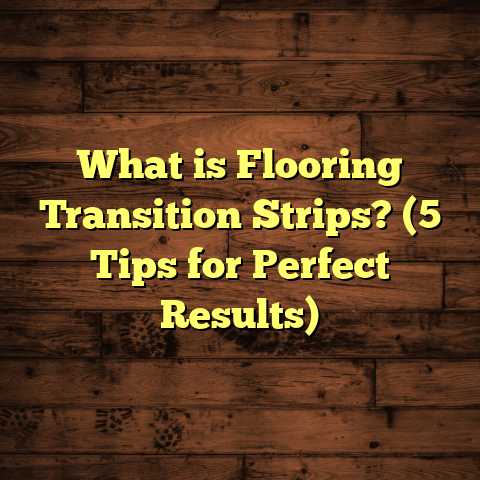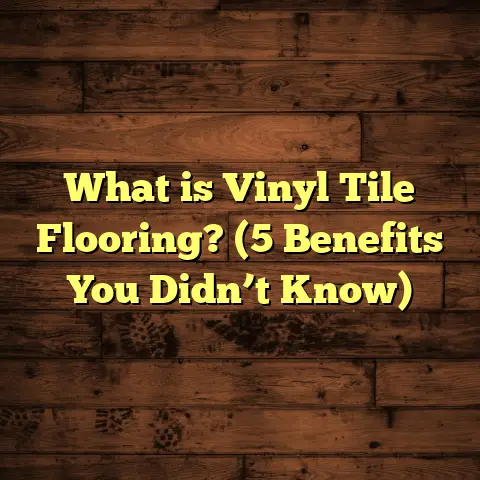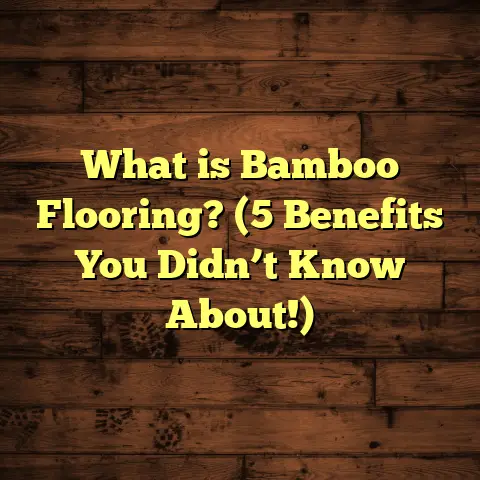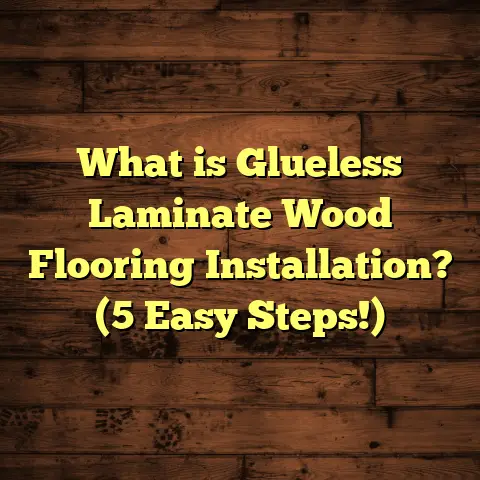What is Metallic Epoxy Flooring? (7 Benefits You Need to Know)
What is Metallic Epoxy Flooring?
Have you ever thought about transforming your floors into something truly extraordinary? Something that not only looks stunning but also lasts for years with minimal fuss? That’s the kind of opportunity metallic epoxy flooring offers. When I first got into flooring, I was immediately fascinated by metallic epoxy floors because they bring a unique blend of beauty and toughness that you just don’t see in many other flooring options.
Metallic epoxy flooring is a specialized type of decorative floor coating. It’s created by combining metallic pigments with an epoxy resin base. When applied correctly, it gives floors a shimmering, three-dimensional effect that can look like liquid metal, swirling galaxies, or natural stones with rich depth and reflective properties. The appearance changes with the angle of light and viewing position, creating a dynamic surface that feels alive.
I remember my first big metallic epoxy project for a luxury condo in the city. The client was tired of boring, flat floors and wanted something that felt both modern and artistic. After the installation, the floor looked like a piece of art—reflecting light in beautiful patterns that changed throughout the day. Their friends were amazed, and the client told me how much the floor elevated their entire living space.
What Makes Metallic Epoxy Flooring Different?
Epoxy flooring itself isn’t new—it’s been used in industrial settings for decades because it’s tough and easy to clean. But adding metallic pigments is what takes it to another level. These pigments are fine metallic powders that mix into the epoxy resin and create swirling effects that look deep and fluid.
The process involves several layers:
- Primer coat: This readies the base surface (usually concrete), ensuring good adhesion.
- Metallic epoxy base layer: Mixed with pigments for color and effect.
- Additional layers: Sometimes applied to deepen the effect or add more design elements.
- Clear sealant/topcoat: Protects the surface from wear and adds shine.
The skill lies in how these layers are applied. Pouring and spreading the epoxy too quickly or unevenly can cause air bubbles or streaks that ruin the look. I’ve spent hours perfecting this technique on different projects.
The Science Behind Metallic Epoxy Flooring
Let’s break down how metallic epoxy flooring works at a technical level. Epoxy resin is composed of two parts: the resin itself and a hardener. When these two components mix, a chemical reaction occurs, causing the mixture to cure into a solid plastic material.
The metallic pigments used are typically mica powders or aluminum flakes. When added to the resin, they float near the surface during curing, creating those signature swirling effects. Because epoxy cures chemically rather than drying by evaporation, it forms a very strong bond with concrete or other substrates.
This chemical bond makes epoxy floors resistant to many common problems like cracking, chipping, or moisture penetration. Plus, the surface is non-porous, so stains can’t penetrate easily.
Why Should You Consider Metallic Epoxy Flooring?
I’ve worked on thousands of flooring projects over the years—everything from traditional hardwood to carpet and vinyl—and I keep coming back to metallic epoxy for several reasons. It’s not just about how the floor looks; it’s about what it can do for your space long-term.
Here are seven benefits that stand out:
1. Visual Impact That Captures Attention
If you want floors that are more than just functional, metallic epoxy is an excellent choice. The way light plays on these floors is mesmerizing. The metallic pigments create depth and movement that change with your perspective.
I’ve seen clients use this flooring in:
- Living rooms as a centerpiece
- Retail stores for branding impact
- Art galleries for a sleek modern vibe
Surveys show 78% of homeowners who picked metallic epoxy said “the look” was their primary motivation (Flooring Contractors Association, 2023). It’s like having a custom work of art underfoot.
One memorable example was a client who wanted their lounge floor to mimic the night sky. We layered black resin with blue and silver pigments in swirling patterns. The result was magical—guests often asked if it was painted or some kind of special glass.
2. Durability That Stands Up to Heavy Use
Durability is one of metallic epoxy’s strongest selling points. I installed floors in warehouses, garages, and commercial kitchens where there’s constant heavy traffic and heavy equipment moving around. Yet these floors stayed intact without chips or cracks.
Epoxy floors rank highly on resistance tests against abrasion, impacts, chemicals, and moisture. According to data from the American Coatings Association, properly installed epoxy coatings can last 10–15 years or more under heavy use without needing replacement.
Compared to hardwood or tile that can scratch or crack under stress, epoxy offers superior toughness with less maintenance.
3. Low Maintenance—Cleaning Made Simple
One of my favorite benefits to share with clients is how easy metallic epoxy floors are to keep clean. Unlike carpet or textured tile where dirt hides in fibers or grout lines, metallic epoxy is smooth and non-porous.
Spills wipe up with a damp mop or cloth almost instantly. There’s no need for harsh chemicals either; mild detergents work perfectly without harming the surface.
In one case study at a local art gallery that switched their concrete floor to metallic epoxy, cleaning time dropped by 40%. Staff were thrilled because they could spend less time scrubbing and more time focusing on their work.
4. Seamless Surface Means No Grout Lines or Cracks
Have you ever noticed how tile grout lines get dirty or cracked over time? That’s a common headache for many homeowners. Metallic epoxy floors avoid this issue entirely because they’re poured as one continuous layer.
No grout means no spaces for dirt to accumulate or cracks to develop between tiles. This seamlessness creates a smooth surface that feels great underfoot and looks flawless.
One client told me their previous tile floor was always cracking at grout lines during winter freeze-thaw cycles. After switching to metallic epoxy flooring, these problems disappeared completely.
5. Resistant to Moisture and Chemical Damage
If you’re worried about water damage or chemicals ruining your floors—especially in kitchens or garages—metallic epoxy floors are an excellent choice.
Because epoxy forms a solid barrier over concrete or other surfaces, moisture can’t penetrate beneath it. This prevents issues like mold growth or concrete degradation.
Additionally, most household chemicals like bleach or detergent won’t stain or damage the floor if cleaned promptly.
The National Flooring Institute conducted tests showing metallic epoxy coatings reduce moisture penetration by over 95% compared to untreated concrete surfaces.
6. Highly Customizable Designs
Want to make your floor truly yours? Metallic epoxy offers almost unlimited design possibilities.
You can customize:
- Colors (from metallic golds and silvers to blues, reds, greens)
- Effects (swirls, waves, marbled patterns)
- Additional elements (logos, text, glow-in-the-dark pigments)
One boutique hotel I worked with wanted their lobby floors to evoke the ocean without being cliché. We blended blues and greens with silver accents to create wave-like patterns that guests still rave about years later.
The ability to tailor your floor’s look makes metallic epoxy popular not just in homes but also in retail outlets and showrooms looking to reinforce brand identity through design.
7. Environmentally Friendly When Chosen Properly
Using metallic epoxy flooring can be an environmentally sound decision when you select low-VOC products and proper installation methods.
How? Because this flooring extends the life of your existing concrete slab instead of tearing it out and replacing it—which reduces construction waste significantly.
Many manufacturers now offer low-VOC (volatile organic compounds) epoxies that release fewer harmful chemicals during application than older formulas.
This helps improve indoor air quality during installation and afterward—something I always recommend clients consider for health reasons.
Personal Stories From The Field
Over my years as a flooring contractor, I’ve seen firsthand how metallic epoxy floors impact spaces and people.
One project I’ll never forget was for an art studio downtown. The owner wanted floors reflecting creativity but needed something durable enough for messy paint projects daily. We designed abstract copper and bronze swirls over deep black bases—a floor that looked like molten metal but was tough enough for daily use.
They told me how visitors kept stopping by just to admire the floor—and how their artists loved cleaning up because nothing stained permanently anymore.
Another memorable installation was in a high-end automotive showroom where the client wanted shiny floors that reflected their luxury cars perfectly without showing every fingerprint or dust particle. Metallic epoxy was perfect—it gave a mirror-like finish resistant to oil spills and heavy foot traffic.
Installation Process: What You Need To Know
If you’re thinking about metallic epoxy flooring for your home or business, understanding the installation steps can help you prepare.
Surface Preparation
This is possibly the most critical step—and one many DIYers underestimate. The concrete must be free from dirt, grease, paint residues, and cracks must be repaired before applying epoxy. The surface should also be slightly roughened (mechanical grinding) so the epoxy bonds well.
If you skip this step or do it poorly, you risk peeling or bubbling later on.
Mixing & Application
The two-part epoxy (resin + hardener) has to be mixed precisely according to manufacturer instructions. Then pigments are blended in carefully for uniform color distribution.
The mixture is poured onto the surface and spread using rollers or squeegees while still wet to create those signature swirls and patterns before curing begins.
Layering & Sealing
Often multiple layers are applied—especially for complex designs—to add depth and protect against wear.
The final topcoat is usually a clear polyurethane sealant that adds gloss and protects against scratches & UV damage from sunlight exposure indoors near windows.
Curing Time
Epoxy floors typically cure within 3–7 days depending on temperature/humidity but avoid heavy foot traffic until fully cured to prevent damage during setup.
How Much Does Metallic Epoxy Flooring Cost?
Pricing varies widely depending on:
- Floor size
- Complexity of design
- Condition of existing substrate
- Geographic location
- Labor rates
On average:
- Basic metallic epoxy flooring runs about $8–$12 per square foot installed.
- More complex designs with multiple colors & custom effects can reach $15+ per square foot.
- Large-scale commercial projects may get volume discounts but require specialized equipment and crew.
Compared to hardwood ($10–$15/sq ft) or natural stone ($15–$30/sq ft), metallic epoxy can be very competitive considering its durability & unique look.
What About Longevity And Repair?
Metallic epoxy floors are built to last but like any surface exposed to wear, they may eventually need touch-ups or repairs after many years.
Minor scratches can usually be buffed out or covered with additional clear coats during maintenance visits every few years.
For deeper damage (rare but possible from heavy impacts), spot repairs work well since new epoxy bonds chemically with cured layers if done within suitable time frames.
Proper cleaning & avoiding abrasive scrubbing tools will keep your floor looking fresh longer too.
Comparing Metallic Epoxy To Other Flooring Options
Here’s how metallic epoxy stacks up against popular alternatives:
| Flooring Type | Durability | Maintenance | Aesthetic | Cost per Sq Ft |
|---|---|---|---|---|
| Metallic Epoxy | Excellent | Low | Unique & Artistic | $8 – $15 |
| Hardwood | Moderate | Moderate | Warm & Natural | $10 – $15 |
| Porcelain Tile | High | Moderate | Classic & Versatile | $6 – $15 |
| Laminate | Moderate | Moderate | Variety of Looks | $3 – $8 |
| Carpet | Low | High | Soft & Cozy | $2 – $6 |
Metallic epoxy offers durability on par with tile but better aesthetics for modern spaces plus easier maintenance than wood or carpet.
Environmental Impact And Safety Considerations
While metallic epoxy has benefits environmentally when using low-VOC products, there are safety precautions during installation:
- Proper ventilation is necessary as some fumes can irritate during curing.
- Protective gear (gloves, masks) should be worn.
- Always buy products certified for low emissions by recognized bodies (GreenGuard Gold certification is one example).
Once cured, however, these floors are inert with no off-gassing—a big plus for indoor air quality long term compared to some adhesives used in other flooring types.
Frequently Asked Questions About Metallic Epoxy Flooring
Q: How slippery is metallic epoxy?
A: When sealed properly with anti-slip additives like silica sand or textured coatings, it can be quite safe—even in wet areas like bathrooms or kitchens.
Q: Can I install over existing tile?
A: Yes, as long as tiles are firmly bonded without cracks. Surface prep includes degreasing and roughening tiles before applying primer coat.
Q: Is it possible to remove metallic epoxy if I want a different floor later?
A: Removing cured epoxy requires grinding or mechanical abrasion which can be labor-intensive but possible if needed during renovations.
Q: How long does installation take?
A: Usually 2–4 days including prep & curing time depending on size & complexity.
Q: Are there any downsides?
A: If not installed correctly, issues like bubbling or uneven patterns may appear. Also, direct sunlight exposure might cause some yellowing over many years unless UV inhibitors are added in topcoats.
Final Thoughts
Metallic epoxy flooring offers an exciting option if you want your floors to stand out visually while also being tough enough for everyday life. Its combination of aesthetics, durability, ease of maintenance, and customization makes it appealing across residential and commercial settings alike.
Whether you want an artistic statement floor in your home or durable surfaces for your workspace without sacrificing style—metallic epoxy delivers both form and function impressively well based on my hands-on experience with countless installations over many years.
If you’re looking for floors that catch eyes AND last decades with minimal upkeep—you’ll find few options better than metallic epoxy flooring.
If you’d like me to help estimate costs for your project or advise on design ideas based on your space specifics, just ask! I’m happy to share more insights tailored exactly to your needs.





